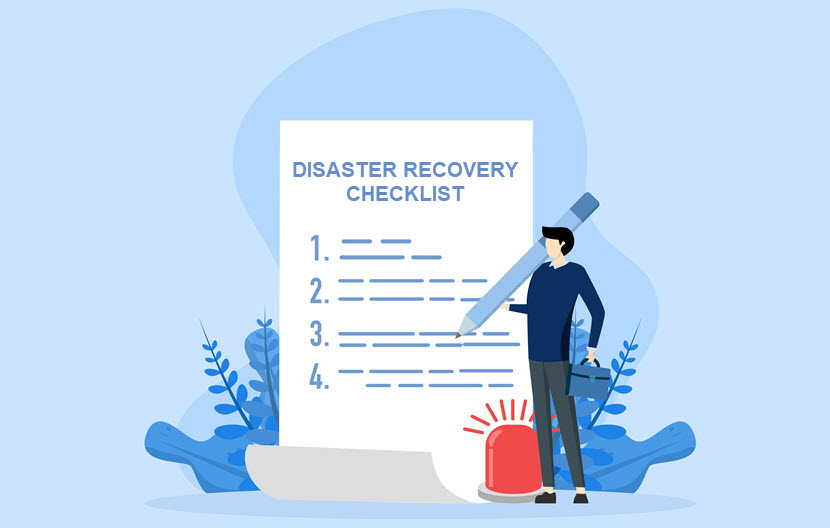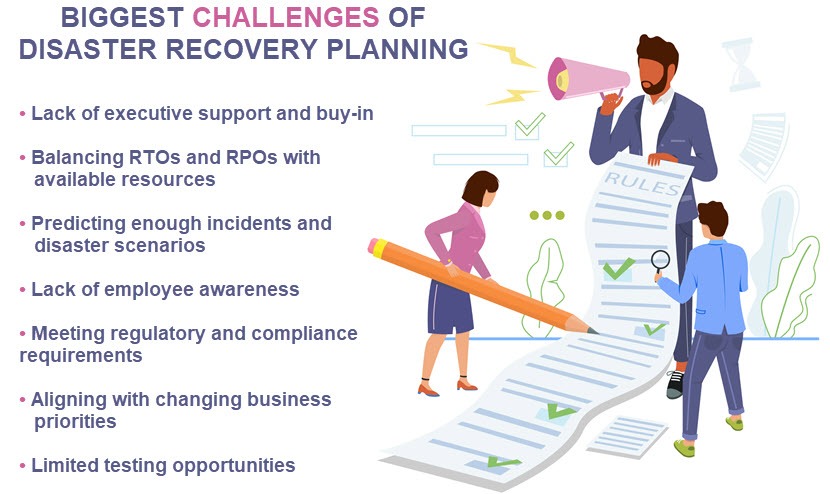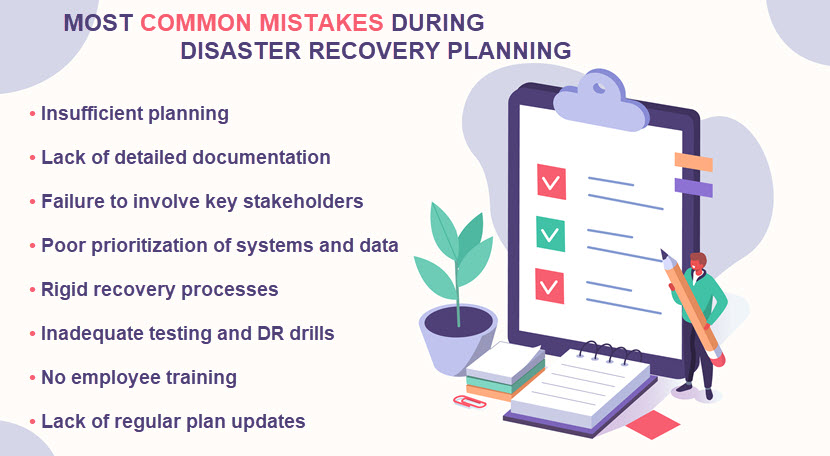Disaster recovery data center checklist
Home / Disaster Recovery / Disaster Recovery Plan Checklist - 13 Critical Points
Meeting disaster recovery (DR) objectives requires careful planning with clear priorities and accurate risk assessments. Such plans are often challenging to create for various reasons (complex IT systems, many moving parts, resource constraints, etc.), which is why we decided to put together this DR plan checklist.
Below is a 13-step disaster recovery plan checklist that helps create a well-rounded and flaw-free DR plan. We also included a downloadable questionnaire that further ensures you do not miss anything vital during disaster recovery planning.
Check out our Disaster-Recovery-as-a-Service (DRaaS) page if you prefer ready-made DR solutions over a DIY checklist.

Disaster Recovery Plan Checklist
The disaster recovery checklist below takes you through the DR planning process one step at a time and helps create an optimal strategy for minimizing the impact of IT disruptions.
Download our DR planning questionnaire and use it alongside this checklist to ensure your DR plan has no gaps.
Set Clear Objective(s)
The objective section of a DR plan states the purpose and the scope of the plan. Here are a few examples:
- Achieve an RTO of 5 hours for a mission-critical system to ensure minimal downtime in case of an incident.
- Maintain an RPO of 8 hours for a database to minimize data loss and ensure data integrity.
- Restore the online transaction system within 2 hours of a disruption to ensure minimal impact on customer service.
- Establish a separate backup data center to ensure business continuity in the event of a primary site failure.
Seek the input of key stakeholders during the objective-setting process. Consider the viewpoints of executive leadership, department heads, IT personnel, and other relevant staff members.
If you have multiple objectives for your DR plan, assign priorities to each goal. The ranking will likely change as you get deeper into our disaster recovery plan checklist, but early prioritization helps with resource allocation.
Take Inventory of Relevant Hardware, Data, and Software
Identify all hardware and software assets within the scope of your objective, including:
- Servers.
- Workstations.
- Networking devices and connections.
- Storage devices.
- Applications.
- Databases.
- Cloud instances.
Create a centralized document to track the inventory. Specify the following info:
- Model and serial number.
- Version.
- Configuration settings.
- Network connectivity info (IP addresses, network diagrams, firewall settings, authentication methods, etc.).
- Backup data (schedules, retention policies, scripts, backup tools, locations, and recovery instructions).
- Location.
- Dependencies.
- Any warranties, support contracts, or licensing info.
Map all the data relevant to the system. Mapping data helps identify and prioritize critical files that require recoveries in the event of a disaster.
Categorize assets based on criticality to business operations and assign priority levels for every asset. This grading helps identify the impact of potential failures later in the DR plan checklist.
Remember to keep the inventory up to date. IT assets change over time due to upgrades, replacements, and devices reaching EOL, so set a process for regular reviews to ensure the team documents any changes to hardware, software, or data sets.
Conduct Risk Assessments
Once you have full transparency of IT assets, perform risk assessments. Identify potential threats that could impact your organization, such as:
- Natural disasters (fires, earthquakes, hurricanes, floods, etc.).
- Cyberattacks.
- Power outages.
- Hardware or software failures.
- Human errors.
- Insider threat scenarios.
- Pandemics.
Evaluate the likelihood of each identified incident and the potential impact the event would have on your IT operations. Consider factors such as potential:
- Financial losses.
- Data breaches or leaks.
- Downtime.
- Compliance violations.
- Reputation damage.
- Customer impact.
- Operational delays.
- Contractual obligations.
Assign a risk level to each threat based on its likelihood and potential impact. Quantify the impact wherever possible (e.g., revenue loss per hour of downtime). Also, perform a Business Impact Analysis (BIA) to evaluate the potential effects an interruption would have on critical business operations.
Check out our article on threat modeling to learn how companies proactively identify and address risks within IT systems.
Determine Recovery Objectives (RTO and RPO)
Once you finish risk assessments, set RTOs and RPOs for each relevant asset:
- RTO (Recovery Time Objective) is the time frame within which the team must restore an IT asset if it goes down. For example, if a network with an RTO of 15 minutes goes down, the DR team must restore network functions in 15 minutes or less.
- RPO (Recovery Point Objective) is the acceptable amount of data (measured by time) you can afford to lose during an incident. For example, a database with an RPO of 4 hours means that the organization can tolerate up to 4 hours' worth of data loss in the event of system failure.
Both metrics are vital to disaster recovery:
- RTOs determine app and infrastructure recovery expectations that dictate most DR-related decisions (whether you invest in hot or cold sites, the necessary failover speed, expected response times, recovery step sequences, etc.).
- RPOs help determine the backup frequency and acceptable data losses in times of crisis.
Here's a general process for defining an RTO:
- Understand the consequences (e.g., loss of customers, SLA violations, regulatory penalties, etc.) of an IT asset going down.
- Determine the maximum acceptable amount of downtime.
- Consider any dependencies between systems or processes (if a critical system relies on another system, the two must have compatible RTOs).
- Assess the feasibility of the defined RTO based on available resources, the complexity of recovery, and associated costs.
Setting RPOs is more straightforward:
- Identify your organization's sensitive files (e.g., customer PII, financial data, intellectual property, transaction records, etc.) and critical data (e.g., server configurations or password databases).
- Understand the acceptable amount of data loss based on business operations, compliance requirements, and legal obligations.
- Set an RPO based on how much data you are ready to lose without too many consequences.
Our backup and restore services enable you to safely back up valuable data to the cloud and achieve any RPO.
Account for Employees
Ensuring the safety of employees is vital during any disruptive event, so your disaster recovery plan must include instructions on protecting the workforce during a disaster.
Here's what to include in this section of your DR plan:
- A reliable communication system to keep everyone informed about the disruptive situation.
- Office evacuation plans tailored to different disaster scenarios.
- Emergency contact lists.
- On-site emergency resources and supplies (first aid kits, emergency medical equipment, food and water supplies, flashlights, etc.).
- Procedures for verifying personnel safety and accounting for all employees.
- Shelter-in-place protocols (instructions for sheltering during certain types of disasters, such as severe weather or an attack on the facility).
- Relevant business continuity plans (e.g., remote work arrangements, alternative work locations, or temporary relocation options).
- Post-disaster recovery and support for affected employees.
Organize regular training sessions to familiarize the workforce with emergency procedures, evacuation routes, and safety protocols. Use these sessions to also raise awareness about potential risks employees might face during work.

Focus on Prevention
While the primary focus of a DR plan is to define procedures for recovery after a disruptive event, your plan should also include prevention measures. These precautions reduce the probability and severity of incidents.
Here are a few examples of how thinking ahead helps prevent incidents from spiraling out of control:
- An uninterruptible power supply unit provides backup power during electrical outages, preventing data corruption caused by sudden power loss.
- Automated fire suppression systems often make the difference between a small incident and a fire that takes out the entire server room.
- A proactive maintenance schedule helps identify flaws in hardware before you face disruptive equipment failures.
- Ransomware prevention and recovery measures stop the infection at the first infected device before it spreads to the rest of your network.
- Redundant storage arrays prevent various events that normally lead to permanent data loss.
This section of your disaster recovery plan is an ideal opportunity to address vulnerabilities and minimize the impact of disruptive events.
Create a Data Backup and Recovery Strategy
This part of our disaster recovery checklist helps develop a data backup strategy. Let's go step by step:
- Assess data: Assess the data you analyzed earlier in the DR plan checklist. Consider the criticality, volume, change frequency, and the required RPO for each data set.
- Define backup strategies: Determine appropriate backup strategies (full, incremental, differential) for each data type based on RPOs and available resources.
- Choose backup storage media: Select the most suitable backup storage media (tape, disk-based, cloud-based, etc.) based on your resources and priorities.
- Boost data redundancy: Ensure data redundancy by having multiple copies of backups and storing them separately. Follow the 3-2-1 rule (create three copies of data, store two versions on different media, and keep one copy off-site).
- Determine backup frequency: Decide how often you must perform backups based on RPOs and data change frequency. Mission-critical data typically requires frequent or even real-time backups.
- Automate backups: Use automation tools to streamline the backup process and reduce error rates.
- Set up monitoring: Continuous monitoring tracks the status of backups, identifies failures, and triggers alerts if something goes wrong with duplicate data.
Our article on backup strategies provides an in-depth guide to creating well-rounded and cost-effective data backup strategies.
Define Recovery Protocols
Create step-by-step recovery procedures for each critical system or process based on their criticality and RTO requirements. The level of granularity varies depending on the plan's objectives, but you should ideally have instructions for every disruptive event identified in the earlier stages of this DR plan checklist.
Each recovery procedure must include the following info:
- An introduction that outlines the recovery's purpose, scope, and contacts for assistance.
- An overview of systems and processes covered by the procedure.
- The so-called triggers that initiate the recovery process (a system failure, ransomware detection, reports of a natural disaster, etc.).
- Go-to stakeholders (both for response procedures and the creation of the recovery document).
- The steps to activate the team responsible for the recovery process.
- A list of the necessary resources, tools, and equipment required for the recovery process (e.g., backups, recovery servers, software licenses, passwords, network connectivity info, etc.).
- Detailed processes for assessing the impact of the incident.
- A step-by-step breakdown of the actions required to restore the affected system or process (startup procedures, configuration data, failover instructions, data recovery procedures, infrastructure restoration steps, etc.) and a sequence of recovery activities.
- Post-recovery verification and testing procedures.
- Escalation procedures in case of unforeseen issues during recovery.
- Detailed failback instructions.
Test recovery protocols several times to validate their effectiveness. Run mock recovery simulations to identify any gaps or weaknesses in the plan and make necessary adjustments until you meet the required RTOs.
Create Disaster Recovery Sites
Most DR strategies involve moving workloads to an alternate location if the primary infrastructure goes down. You have three options when setting up secondary sites:
- Cold site recovery: You set up a secondary IT site with the necessary infrastructure and equipment but without the actual data or software. Cold sites have long RTOs but low setup and maintenance costs.
- Warm site recovery: You set up a partially equipped secondary site with pre-installed software, databases, and configurations. Warm sites offer faster recovery times than cold sites but cost more money to maintain.
- Hot site recovery: You set up a fully operational secondary site that mirrors the primary infrastructure in real time. This strategy provides the fastest failover and failback times but is also the most expensive option.
Organizations set up secondary sites at an off-site data center or in the cloud. The cloud-based strategy offers more scalability, leads to generally quicker restorations, and is more cost-effective since there is no duplicate hardware.
Learn more about cloud disaster recovery and the benefits of backing up mission-critical IT assets and files into the cloud.
Define DR Stakeholders and Response Teams
Next, decide who will be a part of the DR team and what each person's responsibilities will be in case of an incident.
A common name for this part of a DR plan is the mission-critical hierarchy of personnel functions. In a nutshell, this is a list of key stakeholders and their disaster response duties.
Here's a step-by-step instruction on how to pick stakeholders and create a go-to DR response team:
- Determine current stakeholders of valuable systems. Depending on the asset, these decision-makers could be executive leadership, department heads, IT personnel, security teams, operations staff, etc.
- If you're keeping DR efforts in-house, we recommend you assign the current stakeholders with recovery duties. Bringing in new stakeholders creates confusion, which is the last thing you want in your DR plan.
- Communicate the responsibilities of each stakeholder in the recovery process. Take the staff through the specific tasks required to restore operations optimally.
- Engage with stakeholders and decide what teams they require to meet your DR expectations.
- Define response teams you must assemble for disaster recovery. Typical response teams include an Incident Management Team (IMT), Cyber Incident Response Team (CIRT), IT Recovery Team, Communication Team, Facilities Team, and Security Team.
- Designate or enable stakeholders to choose team leaders for each response team. Go with individuals with the necessary skills, knowledge, and authority to coordinate the staff during a disaster.
- Identify staff members who will be part of each response team. Remember to assign backup team members to address any absences or overlapping duties.
Remember to provide training to response team members to familiarize them with DR roles, recovery procedures, and tools.
Establish Communication Channels
Determine communication channels stakeholders and response teams will use during a crisis. Here are a few standard options:
- Email.
- Phone calls.
- SMS.
- Collaboration platforms.
- Instant messaging apps.
- Emergency notification systems.
Collect all relevant phone numbers, email addresses, and alternative contact details of DR stakeholders. Store the contact database securely and ensure it's easily accessible to authorized personnel.
Here are a few best practices to keep in mind when establishing DR communication channels:
- Use multiple communication channels to lower the likelihood of teams being unable to reach each other during a crisis.
- Regularly update contact info for all DR personnel (stakeholders, employees, response team members, etc.).
- Create communication trees that outline the hierarchical communication order and the relevant stakeholders for each response team. That way, you ensure a clear and efficient flow of info during a crisis.
- Develop incident-specific protocols that outline how teams share info during a disruption (guidelines on the frequency of updates, the level of reported detail, and the escalation process for urgent matters).
- Establish clear priorities for communication during a disaster (e.g., evacuation instructions, safety alerts, critical updates, etc.).
Like other parts of our disaster recovery plan checklist, the communication section requires regular testing to ensure effectiveness.

Define Testing Protocols
Most companies run at least one comprehensive DR drill annually to identify issues and improvement areas. How often you decide to run drills depends on several factors, including:
- The complexity of your IT environments.
- Regulatory or compliance requirements.
- Criticality of systems and data.
- The rate of system changes or updates.
Here's a step-by-step guide to help you through the process:
- Set specific objectives of the DR drill (e.g., validate the recovery procedure, test the RTO and RPO targets, assess how well response teams perform tasks, etc.). A single exercise typically has multiple goals.
- Choose a realistic disaster scenario to simulate during the drill (e.g., a system failure, server room evacuation, cyberattack, etc.).
- Inform the staff about the drill and share the date, time, objectives, and scenario details (unless you decide to perform an unannounced test and see how the team reacts to a realistic simulation).
- Initiate the drill and monitor the DR progress. Record the time for each step and document any issues encountered during the process.
- Conduct a post-drill review to analyze the test outcomes with the participants and stakeholders.
Once you finish a drill, make necessary updates to your disaster recovery plan. For example, you could revise procedures, provide additional resources to staff members, change the recovery step sequence, or add new protocols to the DR plan.
Regularly Revise your Disaster Recovery Strategies
Review and update your recovery protocols regularly. The DR plan must also align with evolving technologies and industry best practices. Revise your DR plan whenever you:
- Make any significant changes to IT infrastructure (e.g., implement new systems, retire old systems, deploy new cloud services, relocate to a new data center, etc.).
- Introduce new critical systems or apps (or make substantial updates to existing ones).
- Make major changes within your organization, such as mergers, acquisitions, restructuring, or shifts in business priorities.
- Run a DR drill and recognize room for improvement.
- Learn about new tools, methodologies, or best practices that can enhance DR capabilities.
A good practice is to make DR planning a component of your broader IT strategy plan. That way, you ensure any IT-related change also requires the team to reassess the validity of DR strategies.
Careful Planning Is Key to Successful Disaster Recovery
Preparation is vital to managing IT disruptions and avoiding costly downtime, which is why most companies view disaster recovery as a no-brainer investment. To be effective, however, DR requires careful and thorough planning, so use this disaster recovery plan checklist to ensure your team does not miss anything vital when creating a DR strategy.



Andreja Velimirovic
Andreja is a content specialist with over half a decade of experience in putting pen to digital paper. Fueled by a passion for cutting-edge IT, he found a home at phoenixNAP where he gets to dissect complex tech topics and break them down into practical, easy-to-digest articles.
- Bare Metal
- Cloud Computing
- Colocation
- Company News
- Compliance
- Data Centers
- Data Protection
- Dedicated Servers
- DevOps
- Disaster Recovery
- Ransomware
- Security Strategy
- Virtualization








